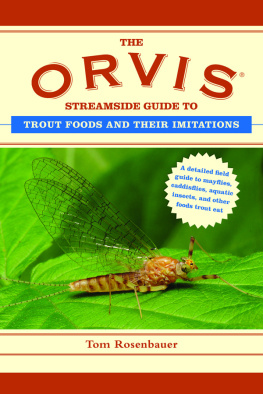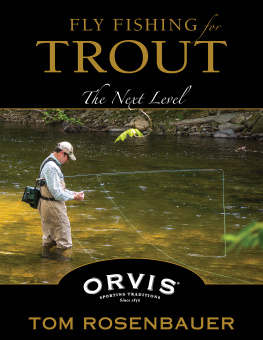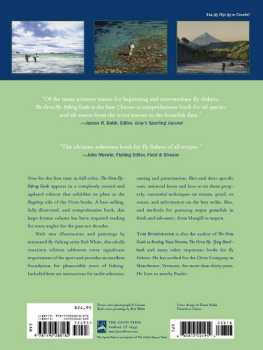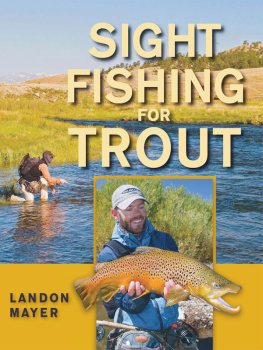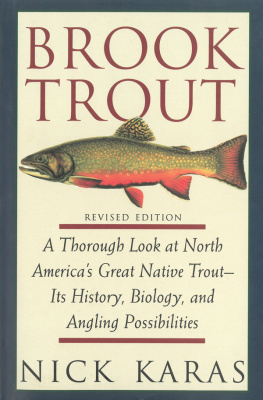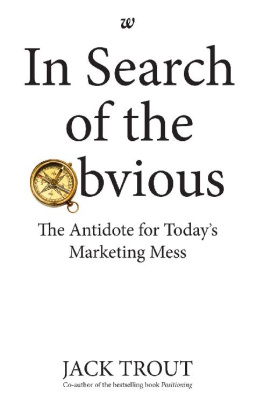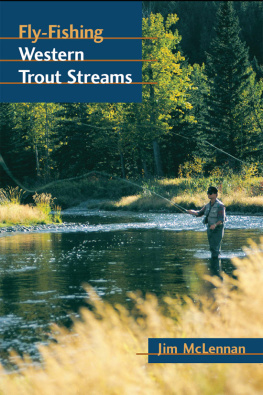Copyright 2000, 2014 by Tom Rosenbauer
Line drawings copyright by Rod Walinchus
Photographs on pages 71 and 152 copyright by Ross Purnell/Virtual FlyShop
Photographs on pages 24, 58, 61, 636, 68, 79, 80, 879, 90 (top), 1016, 1124, 122, 123, 125, 12731, 141, 144, 147, 150, 156, 158, 161 copyright by Henry Ramsay
All other photographs copyright by Tom Rosenbauer
All Rights Reserved. No part of this book may be reproduced in any manner without the express written consent of the publisher, except in the case of brief excerpts in critical reviews or articles. All inquiries should be addressed to Skyhorse Publishing, 307 West 36th Street, 11th Floor, New York, NY 10018.
Skyhorse Publishing books may be purchased in bulk at special discounts for sales promotion, corporate gifts, fund-raising, or educational purposes. Special editions can also be created to specifications. For details, contact the Special Sales Department, Skyhorse Publishing, 307 West 36th Street, 11th Floor, New York, NY 10018 or .
Skyhorse and Skyhorse Publishing are registered trademarks of Skyhorse Publishing, Inc., a Delaware corporation.
www.skyhorsepublishing.com
10 9 8 7 6 5 4 3 2 1
Library of Congress Cataloging-in-Publication Data is available on file.
ISBN: 978-1-62873-782-0
Printed in China
Contents
Acknowledgments
ITS ALWAYS DIFFICULT TO WRITE ACKNOWLEDGMENTS for fly-fishing books because you learn something new from nearly everyone you talk to or fish with. For all those Ive enjoyed sharing oddball theories with on trout-feeding habits over the years, thanks.
But I would like to offer specific thanks and recognition to people who helped me with the areas I am not as familiar with as I should be. For patient help with my questions, Id like to thank Thomas Ames Jr., Jim Cannon, Marty Cecil, Jim Lepage, and Craig Matthews. For assistance in providing photographs of creatures I did not have in my own files, thanks to Henry Ramsay and Ross Purnell. And for helping me make sure this book would be truly helpful and my language clear, thanks to my editors Jay Cassell and Nick Lyons.
Introduction
TROUT ARE PREDATORS AND OCCASIONALLY opportunistic. At times, they will eat nearly any small object that falls into the water, sometimes by mistake and sometimes by design. I have seen them eat berries, spiders, houseflies, butterflies, sticks, pebbles, and cigarette butts. But much of the feeding they do is selective, where a rise to the surface or a dart to an unseen morsel below occurs because that object matched a specific search image that the trout recognized as familiar and edible.
This selectivity is one of the delights of fly fishing, where we are forced to delude a fish into thinking that a piece of fur, feathers, plastic, and steel is an insect, fish, or leech. For hundreds of years, fly fishers have searched for the perfect flythe one that will work on every cast. Fly-fishing magazines and catalogs thrive on this conceit.
When I was a teenager, I fished with an older gentleman on a stream known for its difficult brown and brook trout. In a moment of weakness, old Jim told me of a fly he had discovered that would catch trout every time he put it in the water. His face would furrow with concern as he talked about the fly, because he claimed it would ruin fly fishing in our stream if anyone found out about it. He refused to use it ever again in fear that it would destroy his sport. He once gave me a peek at the fly, as he still had some in his box, and with the scruples of your average fourteen-year-old male, I copied a bunch of them at my fly-tying bench.
You know the rest of the story: I couldnt even budge a fish on Jims fly, but I never told him about it. I didnt want to admit my deceit and spoil his pride. Jim fished on happily for many years, secure in the knowledge that he had the perfect fly in his box, yet principled enough to never use the thing. I think most of us would do the same.
This book is written for the novice and intermediate fly fisher. Its designed to help the person who cant figure out the difference between a mayfly and a caddisfly in flight. Its also for the person who knows his or her insects well, but wants to explore the possibilities of other organisms that trout may eat. This pocket-sized guide wont help you key a mayfly to the species degree. There are many other good books available today if you want to fine-tune your insect identification to that degree. This guide will, however, enable you to identify aquatic insects as members of different taxonomic groups, called orders, such as mayflies, stoneflies, and caddisflies.
All these insects are important as trout foods. Additionally, this guide will help you determine whether other trout foods, such as leeches and crayfish, may be important in your waters. It will also give you a suggested list of imitations you can try if you have no other source for advicebut to be honest, local fly shops and people along the river are better sources for exact patterns to use in your area.
I hope you will keep this book handy in your car, cabin, or kit bag, and that it helps you develop an understanding and appreciation of important trout foods.
How Trout Feed
TROUT ARE SHY AND CAREFUL COLD blooded animals. In contrast to brightly colored bluegillsfish that feed right under your boat and investigate everything that plops into the water near themtrout are well-camouflaged, fussy about what they eat, and will bolt for cover at the slightest disturbance. Think of bluegills as chickadees and trout as woodcock. A chickadee will feed on your windowsill, never try to hide, and can be tame enough to eat out of your hand. Woodcock creep around in heavy brush probing for worms, freeze at the first sign of your presence, and take flight when they think youve spotted them.
Trout evolved over tens of thousands of years to feed in moving water. They are perfectly adapted to preying upon insects. Their streamlined shape allows them to tip up into the current and spear a mayfly nymph from the conveyor belt of moving water that brings them a constant food supply. Their eyesight is sharp enough to spot a tiny midge no bigger than a pinhead when it is still two feet away. Their metabolism is highest when aquatic insects are most active. They can change the color of their bodies to adapt to different stream bottoms; a trout that moves from a dark granite bottom to marble bedrock, for example, will lighten several shades in a few hours. This ability to remain camouflaged allows them to prey on their food supply without being preyed upon in return (except by anglers), which is critical to their survival.
Trout also adapt to still water, revealing their oceanic origins prior to the end of the last Ice Age. In slow pools or lakes, they swim about searching for prey. Although they prefer food that does not run away, when needed they can run down a minnow with blinding speed.
Trout are efficient feeding machines, although they may seem lazy when looked at with an anthropomorphic eye. Over many thousands of years, their tiny brains have evolved into amazing pea-sized computers that can instantly gauge the net energy benefit to be gained from rising through three feet of water to chase a fleeing insect as opposed to plucking a nymph drifting six inches away. Energy used is always balanced metabolically with energy obtained to the point whereperhaps through tastea trout can instantly judge that eating a mayfly will get them more net calories than chasing a water strider.

